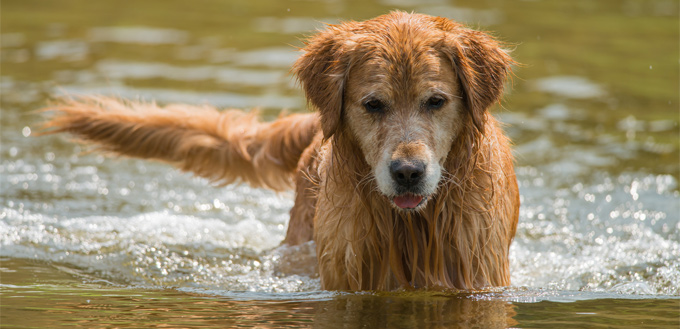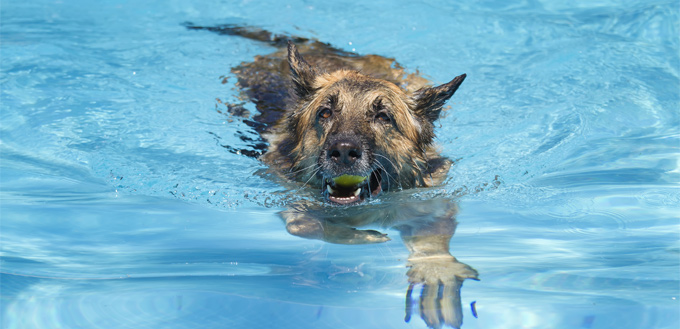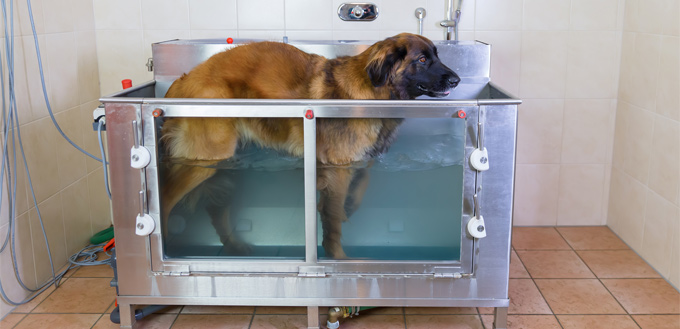There is a good chance that you know at least one person that benefitted from hydrotherapy. Even the people in ancient times knew that water doesn’t provide resistance and allows you to exercise your muscles while relaxing you and having a beneficial effect on your well-being. It doesn’t come as strange then that the word “hydrotherapy” originated in ancient Greece literally translates as “water healing.”
Now, if this works for humans, is there a reason why it wouldn’t work on animals? Believe it or not, it was the horse trainers that first thought to try this, and they figured out that their horses could recover in water after a leg injury or a tiresome race. Thanks to the progress in every area of our lives, hydrotherapy treatments are now available for dogs, too. In fact, you will find numerous vets that believe it can have a beneficial effect on your pet’s mental and physical health.
Before you sign up your Fido for hydrotherapy, we suggest reading this guide to ensure that you know everything about the process and its benefits. The lesson in hydrotherapy for dogs 101 begins – now!

What Is Canine Hydrotherapy?
Hydrotherapy for dogs provides your pet with an aquatic setting they can exercise in. The goal is to secure an environment that will be safe and warm for your pooch. Individual tanks that are large enough in size are created to ensure that your dog has plenty of room to exercise. The water doesn’t provide any resistance, which means there is no danger of muscle strains or stiff joints.
Swimming is recommended for dogs that are going through the recovery process after an operation and are looking for ways to get back in shape. It can also be helpful when recovering from injury, illness, or to slow down the process of aging. Most tanks have an adjustable water level that can vary from shoulder high to ankle deep, which also allows the use of an underwater dog treadmill that your Fido may use for running or walking. Some owners even sign up their pets for hydrotherapy as a leisure activity that they can both attend to stay in shape.
Canine Hydrotherapy – Does It Work?
Allow us to tell you something about the working process of hydrotherapy so that you can understand it better. First of all, you should know that hydrotherapy is conducted in warm water. The temperature will help to expand blood vessels located in your dog’s skin and relax their muscles. Your canine will feel the pain reducing as the temperature of their skin rises.
Warm water may also increase their movement range that was limited by stiffness or swelling of the joints. In case of an injury, swelling and pain in joints are caused by the dog’s body accumulating fluids around the influenced area. Being in warm water may stimulate those fluids to move away and reduce the swelling, especially if it is combined with exercise routines that promote blood flow.
The water will also ensure that canines feel significantly less pressure on the joints that bear the weight of the body compared to walking on dry ground. That should facilitate more comfortable movement and improve their flexibility and balance.
Benefits of Hydrotherapy for Dogs
Veterinarians often do not hesitate when talking about the potential advantages of taking your dog to hydrotherapy. Due to their genetics, canines should feel comfortable being in the water, and any exceptions to that are infrequent. That is why dogs of all ages and breeds are welcome to engage in hydrotherapy. Here is when warm water sessions can help:
During Post-operation Recovery
One of the primary benefits is the same as with humans, and you will see hydrotherapy often prescribed by veterinarians as a part of the program for dog’s rehabilitation after surgery.
According to the experts, it will accelerate the time needed for your pet’s recovery. In some cases, the nature of the trauma might mean that they won’t be able to regain full fitness but exercising in warm water will improve the chances of maximizing their current potential.
The operation might have included hip replacement, maybe they were treated for elbow dysplasia, or had a cruciate repair – whatever the cause and a hydro pool may be able to help.
The Operation is Scheduled Soon
Think of it as a great way to reduce the time needed for recovery after the surgery. If you ensure that your Fido builds strength and tone their muscles before going to an operation, you will prepare them for the post-operative recovery process.
Keeping Your Senior Fido in Shape
Aging affects the dogs, too, and if you have a mature pooch, you probably noticed some signs regarding their stamina and performance declining. Over time, dogs suffer from losing muscle tone, and they are not as fit as before, and some of them may even be suffering from arthritis. Taking your senior pet friend to hydrotherapy is a great way to help them exercise in a warm environment that decreases pain and enables improved movement.
This will assist them in keeping their muscles as toned as possible. According to recent research, taking your dog to a hydro pool is a smart move that can improve their quality of life. In fact, it is believed that a 5-mile walk has the same effect as spending only five minutes in hydrotherapy.
Treating Various Conditions
Your dog might be suffering from arthritis or spondylosis, which is more common in senior dogs. Perhaps your pet has a muscle, ligament, or tendon injury, or even some nerve damage. If you are an owner of German Shepherd or Corgi, you might also be dealing with a spinal cord disease called CDRM. Either way, sessions in a hydro pool may be helpful reverse or at least slow down the effects caused by these conditions. Hydrotherapy may also be useful if your pet is suffering from anxiousness or OCD.
Hydrotherapy for Dogs FAQ:
Q: Can I Use Hydrotherapy as a Way for My Dog to Exercise?
A: Yes, if you have a particularly active puppy or an adult dog that is looking for some engaging activity, you can take them to a hydro pool. They will be more tired than when you take them for a walk and, what’s even more important, they might also have more fun.
We already mentioned that dogs should feel comfortable in the water. Although dogs are natural swimmers, some of them may suffer from a panic attack if they accidentally fall into a river or something like that, especially if that happens for the first time in their lives. In fact, this is why some dogs drown – they get so scared that they can’t find their way out and start thrashing around until they are completely exhausted. However, if you get your pet used to the water, even if it is in a hydrotherapy pool, if they accidentally fall into a lake in the future, there is a good chance they will not panic, which will increase their chances of finding the way to the dry land.

Q: Is Hydrotherapy Useful in Keeping My Dog’s Weight in Order?
A: The list of problems related to obesity in canines is extensive and includes diabetes, heart disease, joint issues, reduced mobility, and a shorter lifespan. That is why it is essential for the pet owner to make sure that his dog maintains a healthy weight. However, if you notice that your Fido gained a few extra pounds, and you feel like they should be slimmer, there are two things you should do.
The first one is a healthy diet and controlled the intake of calories, and the other is taking them to a hydro pool. If you do not have enough time for long walking sessions or fail to find ways for your dog to exercise, hydrotherapy will provide them with a fun and engaging activity in a non-resistant environment. This last thing is particularly important because the joints of obese dogs hold a lot more weight than they should. The water will reduce this pressure and enable your pet to exercise without putting extra pressure on the joints.
Related Post: Best Dog Food for Weight Loss
Q: What Do the Hydro Pools Look Like?
A: The design might be different, but in essence, it all comes down to the same thing – a hydro pool is a big tank with lukewarm or warm water. When it comes to size, the tanks might vary from small to big that can allow the owner to join their pet during the session. Some pools have water jets that serve to make a current for your dog to swim against, but they can also be used for massaging your pet. In most water tanks, the water level can be adjusted, which gives the opportunity of inserting a treadmill that can be used by your dog for running or walking.
Just like in other pools, chlorine and filtration are used to maintain hygiene at a high level. The level of chlorination is the same as in pools that were made to be used by humans. The providers of the service should take care of the pool and check the levels of chlorine on a regular basis. The chlorine shouldn’t be harmful to your dog as they will be rinsed after each session to ensure that as much of this chemical as possible is removed immediately. However, if you notice anything out of the ordinary or have any further questions, you should call your veterinarian.
Q: What Is a Typical Hydrotherapy Routine?
A: We assume that it was your vet that recommended exercising in warm water for your dog and you are getting ready for your first session. Keep in mind that the therapist might ask you some questions about your pet’s medical history to ensure that hydrotherapy is entirely safe for them.
Once you arrive at the location, the staff will make sure to shower your dog because any dirt or loose hair needs to be removed before entering the water for hygienic reasons. Security standards also demand that your dog is equipped with a buoyancy aid or a harness. The process of exercising will involve working out and having a break, and this will be a repeating process throughout the session.
The therapist might stand beside the pool making sure that your dog is doing well and exercising correctly, but they may also jump in the water if needed. In the end, your dog will need to go through another shower to get rid of chlorine in their coat. In some cases, the staff may use a dryer to dry them, but if they are not tolerant, they will resort to towels.
Related Posts: Best Dog Dryer and Best Dog Drying Towels
Q: Can I Join My Dog for Hydrotherapy?
A: The experts believe that going to a hydrotherapy session together might help to strengthen the relationship between the pet and their owner. In some cases, your dog might need some help while in the pool. However, they might not feel that confident being in there just with the therapist because of trust issues. In cases like these, the owner might be allowed to join as long as the size of the tank is big enough to accommodate them both.

Q: How to Choose the Right Place for a Hydrotherapy Session
A: You can always ask for the recommendation from your vet or ask a friend for reference. If you are not sure about the facility, feel free to ask them if they work in collaboration with vets and other pet healthcare providers. You can also ask about the experience of therapists and how long they have been in business, as well as if someone will always accompany your dog in the water.
If you are worried about your dog’s safety, ask about the measures they apply to keep pets safe, as well as what they can do to deal with possible anxiety your dog might experience when entering the pool. Another thing that you may check is how many canines are allowed in the pool at the same time as that may be a good indicator of the therapist’s dedication to individual dogs.
Sources:
- Hydrotherapy, The MSPCA–Angell







